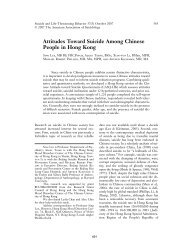Interventions for Suicide Survivors: A Review of the Literature
Interventions for Suicide Survivors: A Review of the Literature
Interventions for Suicide Survivors: A Review of the Literature
Create successful ePaper yourself
Turn your PDF publications into a flip-book with our unique Google optimized e-Paper software.
Jordan and McMenamy 347<br />
psychoeducational and skills building pro- entifically based knowledge about how to as-<br />
grams (Murphy et al., 1998), and combisist survivors is far behind our ability to<br />
nations <strong>of</strong> in<strong>for</strong>mal “survivor-to-survivor” intervene with o<strong>the</strong>r at-risk populations (e.g.,<br />
support and more structured group interven- trauma victims) or with many <strong>for</strong>ms <strong>of</strong> psytions.<br />
Additional techniques that have been chiatric disorder (e.g., depression or anxiety<br />
shown to be <strong>of</strong> help in o<strong>the</strong>r types <strong>of</strong> trau- disorders). Although <strong>the</strong>re are encouraging<br />
matic losses should be explored <strong>for</strong> possible signs that this is changing, it is our impres-<br />
adaptation <strong>for</strong> interventions with survivors sion that survivors have been a low priority<br />
(Doka, 1996; Figley, 1997, 1999). These in- <strong>for</strong> researchers and clinicians in suicidology,<br />
clude <strong>the</strong>rapeutic modalities such as Eye whose main interest has focused on preventa-<br />
Movement Desensitization and Reprocessing tive work with suicidal individuals. It is our<br />
(EMDR; Solomon & Shapiro, 1997) and Trau- strong conviction, however, that “postvenmatic<br />
Incident Reduction (Descilo, 1999), tion is prevention” (Shneidman, 1981), and<br />
cognitive-behavioral <strong>the</strong>rapies (Fleming & that work with survivors is an obvious and<br />
Robinson, 2001), family techniques (Horo- efficient way to contribute to <strong>the</strong> prevention<br />
witz, 1997), and narrative approaches (Ry- <strong>of</strong> future distress, psychiatric disorder, and<br />
nearson, 2001). even suicide itself. We hope that this review<br />
Conclusions<br />
will contribute to <strong>the</strong> growing interest within<br />
suicidology in studying and assisting suicide<br />
There is much work to be done (Far- survivors as <strong>the</strong>y seek healing after this very<br />
berow, 2001; Clark, 201). Currently, our sci- difficult type <strong>of</strong> loss.<br />
REFERENCES<br />
Allumbaugh, D. L., & Hoyt, W. T. Campbell, F. R. (1997). Changing <strong>the</strong> leg-<br />
(1999). Effectiveness <strong>of</strong> grief <strong>the</strong>rapy: A meta- acy <strong>of</strong> suicide. <strong>Suicide</strong> and Life-Threatening Behavanalysis.<br />
Journal <strong>of</strong> Counseling Psychology, 46, 370– ior, 27, 329–338.<br />
380. Clark, S. (2001). Bereavement after sui-<br />
American Foundation <strong>for</strong> <strong>Suicide</strong> Prevention.<br />
(2003). AFSP releases report on survivors<br />
<strong>of</strong> suicide research workshop. Retrieved December,<br />
2003, from http://www.afsp.org<br />
Apel, Y. H., & Wrobleski, A. (1987). Selfhelp<br />
and support groups: Mutual aid <strong>for</strong> survivors.<br />
In E. J. Dunne, J. L. McIntosh, & K. Dunne-<br />
Maxim (Eds.), <strong>Suicide</strong> and its aftermath: Understanding<br />
and counseling <strong>the</strong> survivors (pp. 215–233).<br />
New York: Norton.<br />
Bailley, S. E., Kral, M. J., & Dunham, K.<br />
(1999). <strong>Survivors</strong> <strong>of</strong> suicide do grieve differently:<br />
Empirical support <strong>for</strong> a common sense proposi-<br />
tion. <strong>Suicide</strong> and Life-Threatening Behavior, 29,<br />
256–271.<br />
Brent, D. A., Moritz, G., Bridge, J., Per-<br />
per, J., & Canobbio, R. (1996). Impact <strong>of</strong> adoles-<br />
cent suicide on sibs and parents: A longitudinal<br />
follow-up. <strong>Suicide</strong> and Life-Threatening Behavior,<br />
26, 253–259.<br />
Breslau, N., Kessler, R. C., Chilcoat,<br />
H. D., Schultz, L. R., Davis, G. C., & Andreski,<br />
P. (1998). Trauma and posttraumatic stress disor-<br />
cide—How far have we come and where do we go<br />
from here? Crisis, 22, 102–108.<br />
Constantino, R. E., & Bricker, P. L.<br />
(1996). Nursing postvention <strong>for</strong> spousal survivors<br />
<strong>of</strong> suicide. Issues in Mental Health Nursing, 17,<br />
131–152.<br />
Constantino, R. E., Sekula, L. K., & Rubinstein,<br />
E. N. (2001). Group intervention <strong>for</strong><br />
widowed survivors <strong>of</strong> suicide. <strong>Suicide</strong> and Life-<br />
Threatening Behavior, 31, 428–441.<br />
Crosby, A. E., & Sacks, J. J. (2002). Exposure<br />
to suicide: Incidence and association with suicidal<br />
ideation and behavior: Untied States, 1994.<br />
<strong>Suicide</strong> and Life-Threatening Behavior, 32, 321–328.<br />
Descilo, T. (1999). Relieving naumatic aspects<br />
<strong>of</strong> death with naumatic incident resolution<br />
and EMDR. In C. Figley (Ed.), Traumatology <strong>of</strong><br />
grieving: Conceptual, <strong>the</strong>oretical, and treatment foun-<br />
dations (pp. 155–183). Philadelphia, PA: Taylor &<br />
Francis.<br />
Doka, K. J. (Ed.). (1996). Living with grief<br />
after a sudden death: <strong>Suicide</strong>, homicide, accident, heart<br />
der in <strong>the</strong> community: The 1996 Detroit area surattack, stroke. Washington DC: Hospice Founda-<br />
vey <strong>of</strong> trauma. Archives <strong>of</strong> General Psychiatry, 55, tion <strong>of</strong> America.<br />
626–632. Dyregrov, K. (2002). Assistance from local

















